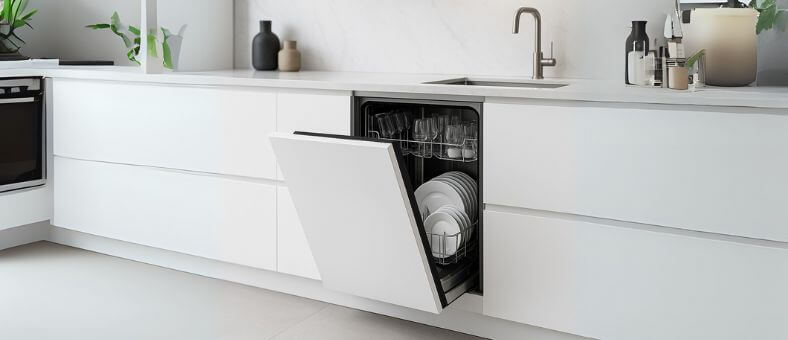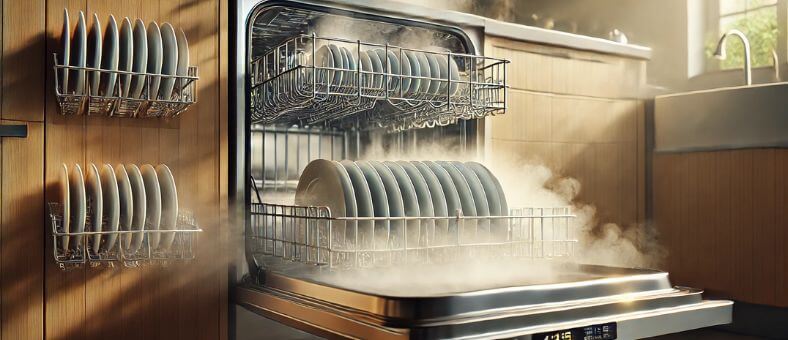Ever wondered, “What is an Integrated Dishwasher?” Well, it’s the stylish solution to your kitchen’s aesthetic needs! Unlike its freestanding counterpart, an integrated dishwasher epitomizes kitchen elegance. It is designed to be a chameleon in your cooking space. Nestled perfectly into a cabinet or cozily tucked under your kitchen countertop, it boasts a door panel synchronized with your kitchen’s decor. This isn’t just a household appliance; it’s a statement of style and sophistication. Beyond its chic appearance, integrated dishwashers come in various types, each bursting with unique features and benefits tailored to modern living. Dive more profound, and you’ll discover it’s more than just a concealed gem; it’s an integral part of a contemporary kitchen.
Rising Popularity!
Did you know? Integrated dishwashers have seen a 35% rise in sales over the past two years, proving they’re becoming a top kitchen essential! No wonder everyone’s talking about them at dinner parties!
Table of Contents
Types of Integrated Dishwashers
In the world of integrated dishwashers, variety abounds. There are several integrated dishwashers, each catering to different needs and kitchen spaces. We will discuss four of these types below.
Full-Height Integrated Dishwashers
Full-height integrated dishwashers, also known as fully integrated dishwashers, are designed to match your kitchen cabinets. Their standard dimensions usually measure about 60 cm (24 inches) in width, 81-87 cm (32-34 inches) in height, and 55-65 cm (22-25 inches) in depth. When not in use, these models are covered with a cabinet door, hiding them from view completely. Full-height dishwashers typically offer the largest capacity, making them ideal for larger households or those who use many dishes.
Semi-Integrated Dishwashers
As the name suggests, semi-integrated dishwashers are only partially hidden. Their standard dimensions usually measure about 60 cm (24 inches) in width, 81-87 cm (32-34 inches) in height, and 55-65 cm (22-25 inches) in depth. The distinguishing feature is the exposed control panel at the top, allowing easy access to the dishwasher’s functions without opening the entire door. While this type of dishwasher still provides a streamlined look, the visible controls offer practicality, making it easier for the user to control the dishwasher without opening the door.
Compact Integrated Dishwashers
Compact integrated dishwashers are ideal for those with limited kitchen space or fewer dishwashing needs. Their typical dimensions are approximately 45 cm (18 inches) in width, 45-50 cm (18-20 inches) in height, and 55-60 cm (22-24 inches) in depth. Even though they’re smaller in stature, these models don’t compromise on features or functionality. They provide most of the benefits of their larger counterparts but in a more space-saving design. A compact integrated dishwasher might be ideal if your kitchen is compact or you live alone or with just one other person.
Slimline Integrated Dishwashers
On the other hand, Slimline integrated dishwashers offer a solution for those with narrow kitchen spaces. Typically, they measure around 45 cm (18 inches) in width while maintaining a standard height of approximately 82 cm (32 inches) and depth of 55-60 cm (22-24 inches). This design provides a narrower profile than standard models, making them an ideal fit for tighter spaces. These dishwashers are especially suited for households with fewer dishes or those who prefer to run the dishwasher more frequently with smaller loads.
Drawer Integrated Dishwashers
A rather innovative type of dishwasher is the drawer-integrated dishwasher. These models usually have a width of around 60 cm (24 inches) with a height of about 41 cm (16 inches) for single drawers and around 82 cm (32 inches) for double drawers. The depth can be approximately 55-60 cm (22-24 inches).
They are designed with a single or double drawer and are highly flexible for diverse households. Single-drawer models are ideal for small families or those who prefer running smaller loads more often. They are compact yet efficient and powerful. The double-drawer models offer even more versatility, simultaneously allowing two different wash cycles. This means you could wash delicate glassware in one drawer on a gentle cycle while washing heavily soiled pots and pans in the other on a more intensive cycle.
Furthermore, drawer dishwashers operate just like a standard kitchen drawer, making them ergonomic by removing the need to bend when loading or unloading. In terms of aesthetics, they meld seamlessly with kitchen cabinetry, making them an excellent choice for those aiming for a sleek and unified kitchen look.
Whether opting for a single or double model, drawer-integrated dishwashers epitomize a blend of style, functionality, and flexibility. They certainly stand out in the realm of integrated dishwashers.
Advantages of Choosing an Integrated Dishwasher
Integrated dishwashers provide many benefits, making them a preferred choice for many homeowners. Here are a few of the top advantages.
- Seamless, High-End Aesthetic: Integrated dishwashers are designed to sit flush with your kitchen cabinetry, delivering a clean, modern look. They disappear into your layout, creating a polished, designer-quality finish.
- Maximized Space Efficiency: Perfect for compact or minimalist kitchens, these units are built directly into your cabinets, optimizing every available space without cluttering your layout.
- Ultra-Quiet Operation: The surrounding cabinetry helps absorb and reduce noise, making integrated dishwashers significantly quieter than most freestanding models—ideal for open-concept living spaces.
- Customizable to Your Kitchen Design: From panel-ready options to various sizes and configurations, integrated dishwashers offer flexibility to match your specific kitchen theme and functionality needs.
- Durable and Long-Lasting Investment: Built-in and often better insulated, these dishwashers are known for their sturdy design and long-term performance, delivering beauty and durability in one package.
Master of Camouflage!
Going integrated isn’t just about saving space; it’s about elegance too! These dishwashers don’t just fit snugly, they vanish into your kitchen decor, making every inch count while keeping style on point. Embrace the blend of functionality and flair!
Potential Drawbacks of Integrated Dishwashers
Despite their benefits, it’s essential to consider a few potential disadvantages of integrated dishwashers.
- More Involved Installation: Integrated dishwashers require precise fitting within your cabinetry, often requiring professional installation, which makes setup more time-consuming and potentially costly.
- Higher Upfront & Maintenance Costs: These models typically cost more than freestanding units. In addition to the higher purchase price, repair and replacement parts may also be more expensive.
- Limited Flexibility & Portability: These dishwashers can’t be easily relocated once built into your kitchen. If you plan to move or remodel soon, this lack of mobility may be a downside.
Integrated Dishwasher Buying Tips
Before purchasing an integrated dishwasher, consider the following:
Kitchen Layout and Design
Ensure your chosen model fits seamlessly into your kitchen. This includes checking dimensions carefully and consulting a professional installer, if necessary.
Capacity
Consider your household size and dishwashing needs. Families may benefit from full-size models, while smaller households might opt for slimline or compact dishwashers.
Energy Efficiency
Look for models with high energy-efficiency ratings to save on utility bills and support environmental sustainability.
Features and Settings
Consider the features most important to you, such as specific wash cycles, delay start, child safety locks, or quiet operation modes. As kitchen appliance trends evolve, an integrated dishwasher fits right in, both in functionality and style.
Choosing an integrated dishwasher requires careful thought and consideration, but the rewards can be substantial. You’ll enjoy efficient dishwashing and a sleek, uncluttered kitchen with a suitable model.
Design and Aesthetics of Integrated Dishwashers
Integrated dishwashers are the unsung heroes of kitchen aesthetics, blending seamlessly with your cabinetry and contributing to a minimalist and uncluttered look. They come in various designs and sizes, catering to different kitchen themes, from modern minimalist to traditional.
Door Design
The dishwasher door is covered with a panel that matches your kitchen cabinetry, making the appliance virtually indistinguishable when closed. The control panel is typically concealed on the top edge of the door. It is only visible when the dishwasher is open.
Size and Fit
Sizes range from slimline for compact kitchens to full-sized for larger households. The exact dimensions will depend on your specific kitchen layout and cabinetry design.
Interior Design
Inside, integrated dishwashers offer a multitude of rack configurations and adjustments for added flexibility. Some even come with third racks specially designed for utensils and smaller items.
Installation Process for Integrated Dishwashers

Installing an integrated dishwasher requires careful planning and execution. It is often advisable to involve a professional installer, especially if you are unfamiliar with carpentry and plumbing.
Measuring Space
Begin by ensuring that the space for your dishwasher aligns with the appliance’s dimensions. Remember to account for the door swing, water, drainage, and power connections.
Installing the Dishwasher
The dishwasher is slid into place after connecting the water supply and drain lines. It’s then secured with screws into the adjoining cabinetry.
Attaching the Door Panel
The door panel, cut to fit and match your cabinetry, is attached to the dishwasher door. Depending on the model, this could be a full-size panel (fully integrated) or a partial panel (semi-integrated).
Finishing Touches
The kick plate is installed at the base, and the control panel settings are finalized. A final test run ensures everything is functioning correctly.
Maintenance Tips for Integrated Dishwashers

- Clean the Interior Regularly: Wipe down the interior walls and racks to remove food debris, soap buildup, and mineral deposits. Use a specialized dishwasher cleaner once a month for a deep clean.
- Inspect and Clean Spray Arms: Clogged spray arm holes can reduce water pressure and cleaning efficiency. Remove and rinse the arms periodically, using a toothpick or brush to clear any blockages.
- Clean the Filter Frequently: Manual-clean filters can trap food particles and grease. Rinse them under warm water every few weeks to prevent odors and maintain strong performance.
- Maintain the Door Seals: Wipe down the door gasket regularly to prevent mold, mildew, and leaks. Replace the seal if it shows signs of cracking or damage.
- Schedule Occasional Professional Servicing: To keep your dishwasher in peak condition, have a technician check the appliance annually, especially water hardness levels, drain efficiency, and any worn-out parts.
Comparing Integrated Dishwashers with Freestanding Models
Are you deciding between an integrated and a freestanding dishwasher? Here’s a simplified breakdown to help you decide which best fits your kitchen and lifestyle.
Design & Aesthetic
- Integrated Dishwashers: Built to blend seamlessly with your kitchen cabinets, these models create a sleek, modern, and high-end look. They’re perfect for minimal or custom-designed kitchens.
- Freestanding Dishwashers: These come in various colors and finishes, making them easy to match with existing appliances. They’re more visible but offer style variety and flexibility.
Installation & Flexibility
- Integrated: Installation can be more involved. They must fit precisely into cabinetry and often need a custom door panel. Once installed, they’re fixed in place.
- Freestanding: Much easier to install and move. Great if you plan to relocate, remodel, or just want less hassle during setup.
Cost Considerations
- Integrated Dishwashers: Usually come at a higher price point due to custom paneling and professional installation. However, they can add long-term value by elevating your kitchen’s appearance.
- Freestanding Dishwashers: Typically more budget-friendly. No need for custom panels, and you can often install them yourself.
Performance & Maintenance
Both types offer similar cleaning power, energy efficiency, and maintenance needs. Performance depends more on the model than the style.
Choose an integrated dishwasher if you value aesthetics and a built-in look. Go for a freestanding model for convenience, flexibility, and a lower upfront cost.
Popular Brands and Models of Integrated Dishwashers
Many well-known appliance brands offer integrated dishwashers with unique features and price points.
Bosch
Known for their quiet operation and energy efficiency, Bosch integrated dishwashers come in full-size and slimline options, and many models include innovative features such as Load Sensor and AquaStop.
Miele
Miele is renowned for its high-quality appliances, and its integrated dishwashers are no exception. They offer features such as a cutlery tray, AutoOpen drying, and QuickIntenseWash.
Whirlpool
Whirlpool’s integrated dishwashers offer good value for money, with features such as a sensor cycle, adjustable upper rack, and soil sensor.
Siemens
Siemens’ integrated dishwashers stand out for innovative features, like VarioSpeed for faster washing and Zeolith drying technology.
Remember, your right brand and model will depend on your needs, budget, and kitchen design.
Is an Integrated Dishwasher Right for Your Kitchen?
Choosing an integrated dishwasher hinges on various factors, including your kitchen layout, design preferences, budget, and lifestyle needs. If you value a seamless kitchen design, favor a clutter-free appearance, and are willing to invest more, an integrated dishwasher could be your perfect match. Not only does it blend flawlessly with your kitchen cabinetry, but it also offers the modern touches and efficiency that contemporary lifestyles demand. It’s about getting those sparkling clean dishes while ensuring water and energy conservation.
However, a freestanding model might be your go-to if you value ease of movement, perhaps frequently relocating or redesigning your space. They’re often more straightforward to install and move and could be a tad lighter on the pocket too.
In the end, it’s all about clean dishes, right? Both integrated and freestanding dishwashers serve that primary purpose efficiently. What distinguishes them is their aesthetic appeal and how they mesh with your kitchen’s vibe and your lifestyle. It’s your kitchen, your choice! Choose wisely.
Final Words on What is an Integrated Dishwasher?
An integrated dishwasher has grown in popularity, marking a 35% increase in sales recently. So, what’s all the buzz about?
At its core, an integrated dishwasher is a stylish kitchen appliance. Unlike regular, stand-alone models, it fits neatly within your kitchen cabinets, camouflaging with your interior design. This makes your kitchen look sleek, as the dishwasher hides behind a matching cabinet door. There are different types, including full-height, semi-integrated, compact, slimline, and drawer dishwashers, each suited for various kitchen sizes and needs.
Why choose an integrated model? It offers a seamless look, uses space smartly, reduces noise thanks to the cabinetry around it, and provides design flexibility. But, there are some challenges. They’re often pricier, harder to install, and, once set, can’t be easily moved.
Before buying, consider your kitchen space, how often you’ll use the dishwasher, and your budget. Consider energy-saving options and specific features you might want.
Both integrated and freestanding dishwashers clean your dishes effectively. The main difference lies in their look and how they fit into your kitchen space. If you want a modern, seamless kitchen design and are willing to spend more, an integrated dishwasher might be the right choice. But always remember, it’s your kitchen and your decision. Make it count!
At WashDryDazzle, we’re dedicated to providing essential insights that make your daily chores effortless. Dive deeper into our comprehensive Dishwasher Education hub to learn more.
Frequently Asked Questions (FAQs)
What are the common cycle options available in integrated dishwashers?
Integrated dishwashers typically offer various cycle options to cater to different dishwashing needs. Common cycle options include Auto, Quick Wash, Eco, Intensive, Glass/Delicate, and sometimes even Sanitize or Steam Wash. Each cycle is designed to provide optimal cleaning for specific loads, ensuring efficiency and care.
How do I choose the right cycle option for my dishes in an integrated dishwasher?
Choosing the right cycle depends on the type and soil level of your cleaning dishes. The Auto or Normal cycle is sufficient for everyday dishes with moderate soiling. The Quick Wash option is ideal for lightly soiled dishes or a quicker wash. On the other hand, heavily soiled pots and pans might require the Intensive cycle. Delicate items like wine glasses benefit from the Glass/Delicate cycle, which uses gentler water pressure and cooler temperatures. Always refer to your dishwasher’s user manual for specific recommendations.
What is an under-counter dishwasher?
An under-counter dishwasher is a type of dishwasher designed to fit directly beneath a standard kitchen counter or countertop. It seamlessly integrates with kitchen cabinetry, providing a neat appearance while optimizing space usage.
How does an under-counter dishwasher differ from a freestanding dishwasher?
Unlike freestanding dishwashers that can be placed anywhere and may have finished sides, under-counter dishwashers are specifically designed to be installed under the kitchen counter. They usually need more finished tops and sides since they are hidden by the countertop and adjacent cabinetry.
What is a customizable dishwasher panel?
A customizable dishwasher panel is a feature available on some dishwashers that allow homeowners to attach a custom front panel to their dishwashers. This means the dishwasher can match the surrounding cabinetry, ensuring a seamless look in the kitchen.
How do I customize my dishwasher panel?
Customizing your dishwasher panel typically involves purchasing a panel-ready dishwasher model and then making a custom panel, often by a cabinetmaker or from the company where you purchased your kitchen cabinets. The panel is then attached to the dishwasher’s door according to the manufacturer’s instructions. It’s essential to ensure that the panel’s weight and dimensions are compatible with the dishwasher’s specifications to avoid operational issues.










